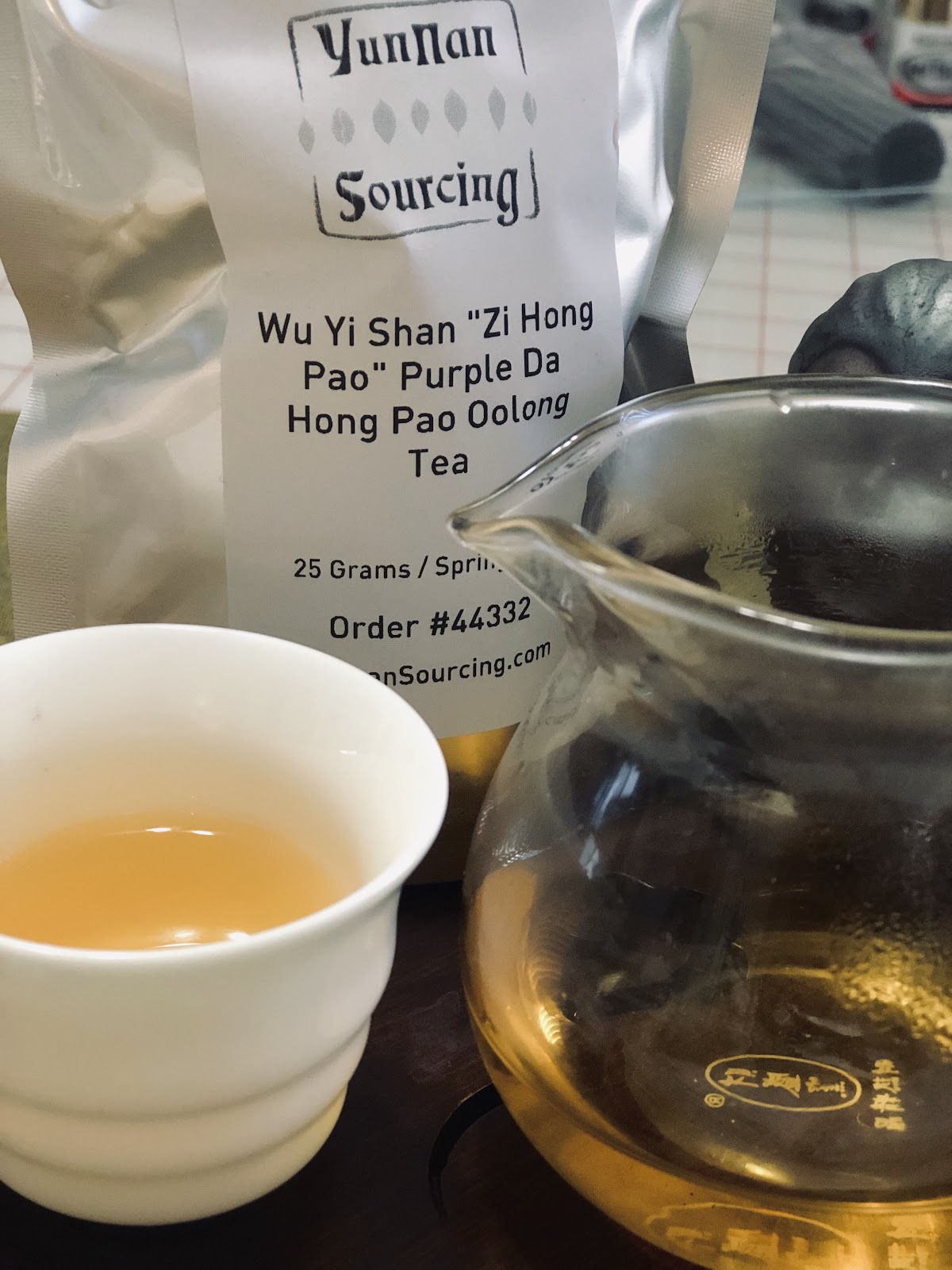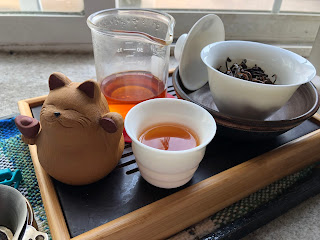A Good, But Slightly Underaged Oolong - Wu Yi Shan "Zi Hong Pao" Purple Da Hong Pao Oolong Tea (Spring 2019)
This tea is part of a recent Yunnan Sourcing Order that I made in September, received in November, and I'm slowly doing an initial taste of the different teas that I ordered.
For this session, I chose: Wu Yi Shan "Zi Hong Pao" Purple Da Hong Pao Oolong Tea (Spring 2019)
 This is a pretty decent tea, and it has the potential to be a VERY good tea. The tea broth is thick, rich, and very juicy. It’s got a good astringency, but never borders on bitter even when pushed. The flavors aren’t complex with primary notes of roast / sweet wood with hints of stone fruit. Even though this tea is a side varietal of Da Hong Pao, it has aspects of a Dan Cong.
This is a pretty decent tea, and it has the potential to be a VERY good tea. The tea broth is thick, rich, and very juicy. It’s got a good astringency, but never borders on bitter even when pushed. The flavors aren’t complex with primary notes of roast / sweet wood with hints of stone fruit. Even though this tea is a side varietal of Da Hong Pao, it has aspects of a Dan Cong.

I think it’d be interesting to see how this ages over time. I think it’ll become an amazing tea. (Side Note: This would make a good grandpa style brewed tea as of right now)
 The wet leaves had high notes of stone fruit turning into sweet sugar
with later infusions. There were low notes of roast, fire, and
wood smoke.
The wet leaves had high notes of stone fruit turning into sweet sugar
with later infusions. There were low notes of roast, fire, and
wood smoke.
The liquid gave off hints of orange/citrus that I did not quite taste in the actual tea.
The tea broth is very thick & viscous, nice on the tongue. This tea goes down easy with a medium to long finish. It has a medium-long astringency that started on the edges of my tongue then the whole tongue,but the tea never got bitter.
There are strong initial wood flavors with hints of fruit (not citrus) at either the beginning or end, depending on the steep, which would then even out as you sipped. It was very pleasant. The flavors were understated, balanced, and quite nice. I rather enjoyed this session.
For this session, I chose: Wu Yi Shan "Zi Hong Pao" Purple Da Hong Pao Oolong Tea (Spring 2019)
From their website:
"Zi Hong Pao" is a purple varietal that's a naturally mutated offshoot from the classic "Da Hong Pao" varietal. It's also called "Jiu Long Pao" (lit. 9 Dragon Robe) or Wu Yi varietal #303. It's "medium-leaf" class of tea, not purely Assamica or Sinensis. The leaves are thick and dense with a purple/red/green color when fresh. Zi Hong Pao is a very rare tea with only about 10 mu of land in total producing this tea. The buds and leaf shoots are slow to grow and the harvest is the last of the spring harvests.
Perhaps the most special aspect of "Zi Hong Pao" is the lovely delicious, thick and pungent tea that it brews. I recommend drinking the rinse. With just a 10 second rinse you are greeted with a vibrant and viscous tea soup. The second through the fifth infusions are really full and exciting to drink. The 6th through 8th infusion is still quite strong and pungent but the needs to be pushed a little bit. Truly a remarkable tea in pedigree, taste and experience.
Late-April into Early May Harvest
Area: Wu Yi Mountains, Xing Zhen, Cao Dun Village
Summary:
I think it’d be interesting to see how this ages over time. I think it’ll become an amazing tea. (Side Note: This would make a good grandpa style brewed tea as of right now)
Brewing
- Leaf: Long strips of dark brown, black, and some green.
- Leaf (Dry): Dry roasted peanuts. Plum or cherry scent
- Leaf (Warm): Dry roast, dried cherries
- Brew Times (seconds): 20, 30, 45, 75, 90,120…
- Brew Temps (F): 200F, 201F, 199F, 199F, 199F
The liquid gave off hints of orange/citrus that I did not quite taste in the actual tea.
The tea broth is very thick & viscous, nice on the tongue. This tea goes down easy with a medium to long finish. It has a medium-long astringency that started on the edges of my tongue then the whole tongue,but the tea never got bitter.
There are strong initial wood flavors with hints of fruit (not citrus) at either the beginning or end, depending on the steep, which would then even out as you sipped. It was very pleasant. The flavors were understated, balanced, and quite nice. I rather enjoyed this session.


Comments
Post a Comment